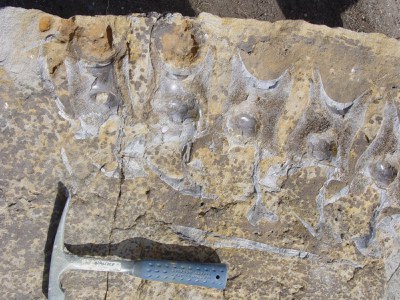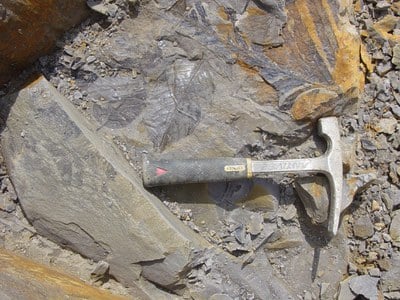FAQs
Q: Why does CDOT protect fossils?
A: The Historical, Prehistorical, and Archaeological Resources Act [Colorado Revised Statute 24-80-401 et al.; a.k.a. State Antiquities Act] protects all fossils on state-owned lands and lands controlled by any subdivision of state government. Title to fossils on state-owned lands is reserved to the state. As such permits are required to collect, damage or destroy fossils covered under the State Antiquities Act. While the requirement to locate and assess the scientific importance of fossils on state-owned lands is not stated explicitly in the law, it is implicit in the requirement to avoid any damage to, destruction or removal of the resource without a permit. The CDOT Staff Paleontologist or any paleontological consultant working for CDOT must hold a current State of Colorado permit to collect fossils on state-owned lands, including CDOT rights-of-way.

Q: Has CDOT collected any good dinosaur fossils?
A: Isolated dinosaur bone fragments have turned up on occasion in CDOT rights-of-way, but only one scientifically important dinosaur find has been made to date. Like most vertebrate (animals with backbones) fossils, identifiable dinosaur fossils are actually quite rare. Invertebrate (animals without backbones) and plant fossils are much more common in the fossil record, and encompass most of the fossils collected for CDOT. An important dinosaur footprint site is preserved in Jefferson County along Alameda Parkway on the east side of Dinosaur Ridge, north of Morrison, in what was once CDOT right-of-way. This site was uncovered during the original construction of Alameda Parkway in the late 1930s. Dinosaur bones and footprints in cross-section can be viewed in Alameda Parkway road cut exposures on the west side of Dinosaur Ridge. For more information on these localities visit the Dinosaur Ridge website.
The Friends of Dinosaur Ridge Visitors' Center is also the current home of a sandstone boulder containing six vertebrae (backbones) of the carnivorous (meat-eating) dinosaur Allosaurus recovered from a US Highway 287 road cut northwest of Fort Collins (photo below). A Colorado State University geologist reported this fossil occurrence to CDOT, and a CDOT maintenance crew loaded the boulder onto a truck and transported it south to its current home near Morrison.
Q: What is CDOT's most scientifically important fossil locality?
A: The Castle Rock Rainforest fossil locality, which was discovered in 1994 adjacent to Interstate 25 in the town of Castle Rock, has been systematically excavated in a cooperative effort with paleobotanists (plant fossil specialists) from the Denver Museum of Nature and Science. The site has produced over 160 different kinds of plants whose morphology indicates that the Castle Rock area was a tropical rainforest approximately 63.8 million years ago. This discovery has radically changed scientists' perceptions of what the Denver metropolitan area looked like about 1.7 million years after the extinction of the non-avian (non-bird) dinosaurs. Previous plant fossil collections, dating back to the 1870s, indicated that recovery of the ecosystem of the entire western United States from the ecologic disaster at the end of the Cretaceous Period-when the non-avian dinosaurs and many other major animal and plant groups went extinct-took 10 million years. Evidence from the Castle Rock locality and several others between Denver and Colorado Springs indicates that in some places the recovery period was much shorter. For more information on this locality, visit the Paleocurrents website.

Q: What happens to fossils collected for CDOT?
A: CDOT's permit to collect fossils on state-owned lands requires that all collected specimens be deposited at state-recognized public museums. Under current agreements, vertebrate fossils are primarily stored at the Denver Museum of Nature and Science.
Q: Can I collect fossils in Colorado's roadsides?
A: No--because the edges of the roadways are part of CDOT's "Right of Way", which belongs to the State of Colorado. Fossil collection is not allowed on state-owned lands without a special permit from the State Historical Preservation Office. But there are other places in Colorado where you might be able to collect fossils! You can ask your local fossil club, museum, or BLM office about good, legal fossil collection locations, or ask about field trip opportunities for people who would like to hunt and collect fossils.
